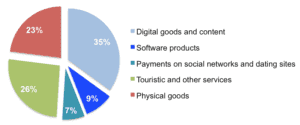Earlier this month the Russian Export Center, a government-backed organization, agreed with eBay Inc. a joint program to help Russian companies reach foreign online consumers, the TASS news agency reports.
Not only will these sellers have their goods featured on eBay, but the company’s Russian staff will also provide them with free consultations about how to start selling and promote offers via the platform.
Russian sellers will also benefit from eBay’s technical support to launch their own online store.
The first hundred companies to approach the Russian Export Center will be granted with free access to eBay, the REC announced.
EBay, however, is not the only available channel to reach foreign customers.
“We’re preparing to launch a new logistics chain from the first mile in Russia to end consumers in North America and Europe via eBay, Amazon and smaller marketplaces,” said Iurii Popolitov, Sales Director at Shiptor, a cross-border e-commerce service provider which thus far had served foreign players selling to Russian consumers.
B2C online sales of Russian companies to international customers reached some $2 billion last year, up 32% from 2015, according to a recent estimate by Russian research agency Data Insight and PayPal. These consumers came essentially from Northern America and Western Europe.

Russian companies’ online sales to foreign consumers. Sept. 2016 data. Source: Data Insights and PayPal
Of said amount, digital goods and content accounted for 35%, software sales for 9%, payments on social networks and dating sites for 7%, touristic and other services for 26%.
Sales of material goods accounted for 23%, or some $460 million. By contrast, Russian consumers’ orders of physical goods on international sites reached some $4.3 billion in 2016, according to NAMO data cited in EWDN’s e-commerce report.
Lower labor costs
While certain experts believe that Russian products have virtually no chance to meet international demand in significant quantities, Popolitov says there is a potential for certain product categories. He cites branded clothing, shoes, some niche food products and crafts as examples.
“Labor costs have become even lower in Russia than in China, Malaysia or Taiwan [as a result of the ruble’s fall in 2014-15]. This provides our products with a significant competitive advantage whie quality remains high,” he believes.
Nevertheless, online export is still hampered by the lack of logistics infrastructure and insufficient experience in international sales, notes Vlad Shirobokov of East-West Digital News.
“Currently, more than 90% of the orders from Russia are registered as C2C parcels due to the complex B2C customs and tax procedures. Market players have been lobbying for simpler procedures for years, but without substantial results so far,” he adds
This article first appeared in East-West Digital News, the international online resource on Russian digital industries, and is reprinted with permission.